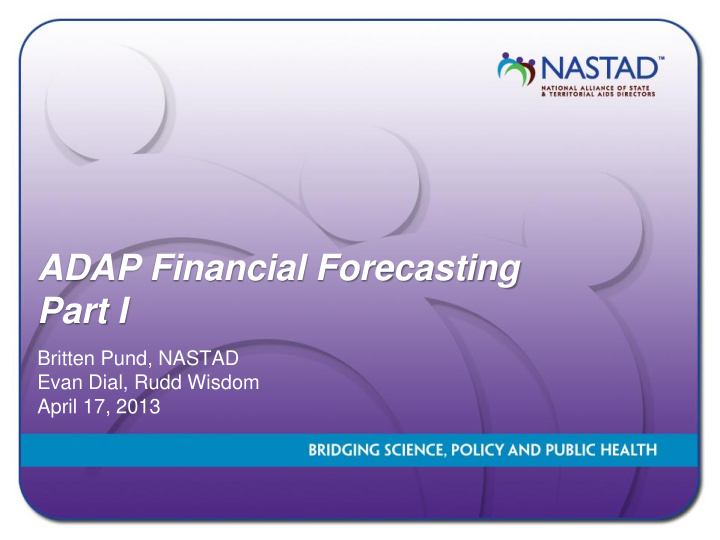



ADAP Financial Forecasting Part I Britten Pund, NASTAD Evan Dial, Rudd Wisdom April 17, 2013
Agenda Financial forecasting and ADAP Projecting fiscal needs for ADAP Using the ADAP financial forecasting model Next steps and TA
Financial Forecasting and ADAP
Characteristics of an Ideal ADAP Financial Forecasting Model Predictive: a model that is adequately able to offer an indication of what the future might hold for an individual ADAP Explanatory: a model that is able to articulate in numbers an accurate picture of the state of ADAP Convenient: a model that is easily accessible and easy to use Adaptable/flexible: a model that is able to be modified based on the individual needs of an ADAP and readily able to meet different conditions (i.e., traditional ADAP vs. insurance) Simple/understandable: a model that is easy to understand and not elaborate or complicated Margin of error: a model that allows for an acceptable allowance for slight error or miscalculation, depending on changing circumstances
Things to Consider What data elements should ADAPs include in a financial forecasting model? What trends should ADAPs be monitoring? What information do ADAPs need to have to understand the data being inputted?
Understanding the Basics: Time Frame ADAPs should use the most recent three to five years of data that is available. The model developed by ADAP uses a minimum of two year (24 months) to allow for programs that have made more substantive changes in the past two years to adequately project costs.
Understanding the Basics: Data Elements Number of clients enrolled by ADAP. Number of clients served by ADAP. Number of new clients enrolled in the program. Complete listing of all funding available for ADAP in the current year, based on funding category. Data on rebates collected. Data on program income collected from back-billing Medicaid. Data on attrition rate.
Examining and Analyzing Trends Enrollment Utilization New enrollment Funding 340B and ADAP Crisis Task Force rebates Attrition rates
Projecting Fiscal Needs for ADAP
The Basis for Historical Data In what context was the data collected? What program changes were taking place that could impact data trends? Was data collected in the same manner in which it is collected currently?
Structure of ADAP What is the enrollment process for clients? How does the ADAP dispense medications? How does ADAP wrap around other payers? Program history, detailing major changes nationally and within state program – ADAP timeline Systems changes
Resources Glossary of important terms Definitions of variables included in the model Variability of projections and seasonality of data Unmet need
ADAP Financial Forecasting Model
The Model The model has two main components: – Traditional ADAP projections (full pay) – Insurance projections The two projections result in a summary worksheet for each component, and for the total ADAP projection for both components combined.
Traditional ADAP Projections: User Interface
Traditional ADAP Projections: Data Input
Traditional ADAP Projections Summary
Insurance Projections: User Interface
Insurance Projections: Data Input
Insurance Projections; Summary
Summary Total
Next Steps and TA
Next Steps and TA A second webinar will be hosted on Wednesday, May 1, 2013 from 2:00 pm to 3:00 pm ET. – This webinar will focus on technical assistance regarding financial forecasting and implementing the model in your state. – This webinar will provide an opportunity for ADAPs who have begun to use the newly developed model to ask questions and receive TA on its use. TA is available for any state on the topic of ADAP financial forecasting.
Resources An electronic copy of the ADAP financial forecasting model and companion document will be sent electronically to ADAP coordinators via the ADAP listserv on Thursday, April 18, 2013. For more information about ADAP financial forecasting, please contact Britten Pund at bpund@NASTAD.org.
Recommend
More recommend